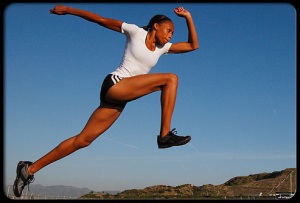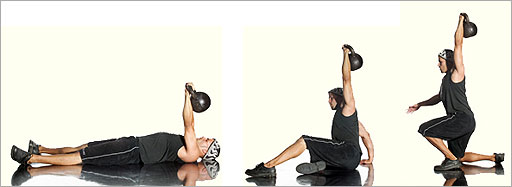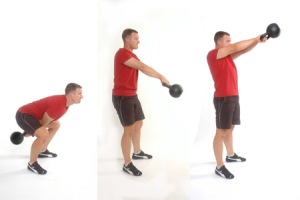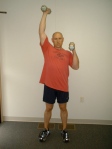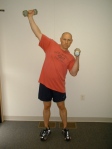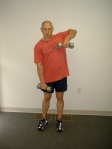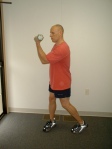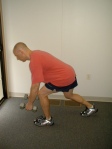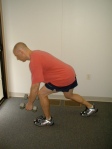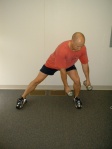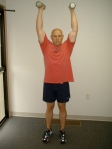
By Doug Gray
Jumping is an action that has implications to everything we do. Squatting, walking, running, lunging, etc. has components of jumping involved. Therefore, jumping better will pave the way to functioning better. A common element of plyometrics and calisthenics is jumping. Jump training is a point of focus in sport, yet has extreme implications to life in general. The topic of jumping initiates many questions to consider, such as the following:
• Is your jump training directly carrying over to that which you are training for?
• Is your jump training better preparing you to execute activities more efficiently, whether in sport or active daily living?
• Is your jump training incorporating all three planes of motion (as the body is intended to function)?
• Is your jump training properly sequenced to be safe and guarantee progress / improvement?
• Is your jump training properly preventing future injury?
• Is your jump training dynamic and variable (i.e. – incorporating two feet to two feet, two feet to one foot, one foot to two feet, and one foot to the same foot)?
As the above questions trigger contemplation to the purpose, logic, and sequencing of one’s training regime, it sets the table for exploration on how to better train the body. A great starting point is identifying and discussing a functional threshold. A functional threshold … the body’s ability to successfully perform the multiple tasks required for what one needs to do and what one wants to do in life. In essence, it leads to productively owning ones three‐dimensional space in completing the desired task at hand. The spectrum of “needs” and “wants” is long and variable, yet lends itself to the following point: it is in ones best interest to expand his / her functional threshold in order to enhance overall performance.
Jump‐Jop‐Hop Explosion, which is part of the Gray Institute’s 3D Matrix Performance Series, is a workout intended to increase one’s vertical, to protect one from injury, as well as to improve one’s strength, flexibility, cardiovascular endurance, coordination, agility, power, speed, reaction, etc. More importantly, it is designed to enhance one’s overall health, wellbeing, and longevity by creating an environment where one can expand his / her functional threshold. Jump‐Jop‐Hop Explosion, as all DVDs in the 3D Matrix Performance Series, consists of both instructional and follow‐along segments.
The terms jumping, jopping, and hopping all refer to the act of loading the lower body and trunk to efficiently and effectively (as well as explosively) unload the body to become airborne in defying gravity. Pure jumping is defined as leaving the surface (or ground) on one foot or both feet and landing on both feet. Pure jopping is defined as leaving the surface on both feet and landing on one foot. Pure hopping is defined as leaving the surface on one foot and landing on the same one foot.
The Chain Reaction™ biomechanics involved with jumping are very similar to that of the lead (or front) leg in gait (or walking). In understanding this better, it is valuable to identify what is known as a Transformational Zone (TZ). A TZ is defined as the period of time when motion changes direction. Moreover, a TZ is the point where eccentric lengthening (loading) of a muscle transforms into a concentric shortening (unloading). The TZ of jumping (when the body compresses before exploding upward or outward) calls for a three‐dimensional Chain Reaction™ throughout the entire body (feet / ankles, knees, hips, trunk, etc.). This load and explode sequencing is a common denominator for all forms of movement. For that reason, Jump‐Jop‐Hop Explosion is not strictly for jumping population, but for all walks of life.Jump‐Jop‐Hop Explosion is a workout that trains the body’s muscles and joints to load and explode in a variety of ways in performing jumps, jops, and hops. Embedded into the workout is a progression that gradually intensifies the workout from round to round (consist of three rounds) by beginning with jumps (two feet to two feet), then shifting to jops (two feet to one foot) and hops (one foot to same one foot). Also, very important to the topic of the DVD, a strategy of safety and progression is performing the workout in initial ranges of motion until the body is comfortable and strong enough to be challenged more (which would involve moving then into mid ranges of motion, and then moving into end ranges of motion).
Additionally, Jump‐Jop‐Hop Explosion positions the body from the top‐down to facilitate and different Chain Reaction™ to add variety and functionality to the workout. For example, both hands are positioned differently in certain portions of the workout to put parts of the body at a biomechanical advantage, while putting other parts of the body at a biomechanical disadvantage, in order to mimic sport and daily activities that the body needs to perform. Of course, these positions are logically organized into all three planes of motion (in front of, above and behind, to the right of, to the left of, rotationally to the right of, and rotationally to the left of the body). Placing the hands in front of the body (anterior at hip) recruits more of the back hip (glute muscles) to execute the task, whereas placing the hands above and behind the body (posterior at overhead) recruits more of the front hip to execute the task. Different positions of the body allow gravity to compress the body differently, as gravity is the competitor of jumping, yet also the best friend when it comes to loading the body to jump.
According to the Gray Institute’s Functional Video Digest Series v2.4, “Jumping: Unleashing the Load” CLICK HERE, jumping is a tri‐plane phenomenon. Also, to enhance jumping, it is imperative that new pathways of loading the body are established and existing pathways are deepened and enhanced. Jumping is not only vertical, but also horizontal and rotational. All these dimensions need to be exploited in any jumping program to better prepare and protect the body in all areas of performance, in which Jump‐Jop‐Hop Explosion successfully exhibits. This needs to be the goal for any athlete: to develop and enhance the gifts and talents that he / she has been given. Therefore, all dimensions need to be attended to in expanding one’s functional threshold. Jump‐Jop‐Hop Explosion is an integral step to this process.











